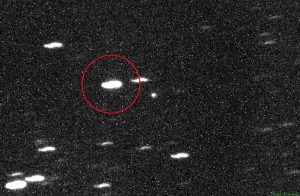Avi Loeb, the ridiculous Harvard astronomer who claimed that the interstellar object ʻOumuamua was a technological artifact, has battened on a different rock that was discovered in July called 3I/ATLAS as the object of his alien fantasies. He’s published his explanation in an in-house journal (which is not peer-reviewed) in a paper titled Is the Interstellar Object 3I/ATLAS Alien Technology?. The answer is “no”, but Avi really wants it to be “yes.” To give him a chance to make his argument, here’s the abstract.
At this early stage of its passage through our Solar System, 3I/ATLAS, the recently discovered interstellar interloper, has displayed various anomalous characteristics, determined from photometric and astrometric observations. As largely a pedagogical exercise, in this paper we present additional analysis into the astrodynamics of 3I/ATLAS, and hypothesize that this object could be technological, and possibly hostile as would be expected from the ’Dark Forest’ resolution to the ’Fermi Paradox’. We show that 3I/ATLAS approaches surprisingly close to Venus, Mars and Jupiter, with a probability of ≲ 0.005%. Furthermore the low retrograde tilt of 3I/ATLAS’s orbital plane to the ecliptic offers various benefits to an Extra-terrestrial Intelligence (ETI), since it allows the object access to our planet with relative impunity. The eclipse by the Sun from Earth of 3I/ATLAS at perihelion, would allow it to conduct a clandestine reverse Solar Oberth Manoeuvre, an optimal high-thrust strategy for interstellar spacecraft to brake and stay bound to the Sun. An optimal intercept of Earth would entail an arrival in late November/early December of 2025, and also, a non-gravitational acceleration of ∼ 5.9 × 10−5 au day−2, normalized at 1 au from the Sun, would indicate an intent to intercept the planet Jupiter, not far off its path, and a strategy to rendezvous with it after perihelion.
The paper is full of the technical details about the orbital mechanics of this object. It’s unpleasantly dry and boring, with occasional insertions of his wild speculations. Fortunately, he also has a blog post titled Is the Interstellar Object 3I/ATLAS Alien Technology? which is enriched for the Loeb lunacy, so I’ll mainly write about that.
Finding a big rock or comet of interstellar origin is not a revolutionary discovery — it’s interesting, but not something that is necessarily indicative that aliens are hitching a ride on it. His justification for suggesting that it’s an alien artifact are tenuous and based entirely on speculations about its trajectory. For instance, it’s approaching on roughly the ecliptic plane.
The retrograde orbital plane (defined by the orbital angular momentum vector) of 3I/ATLAS around the Sun lies within 5 degrees of that of Earth — the so-called ecliptic plane. The likelihood for that coincidence out of all random orientations is 0.2%.
So it’s unlikely that a rock flying through interstellar space would have the particular approach angle that this one has. But wouldn’t any specific trajectory be unlikely? So what?
Another coincidence is that it’s going to pass sorta close to Venus, Mars, and Jupiter.
For its orbital parameters, 3I/ATLAS is synchronized to approach unusually close to Venus (0.65au where 1au is the Earth-Sun separation), Mars (0.19au) and Jupiter (0.36au), with a cumulative probability of 0.005% relative to orbits with the same orbital parameters but a random arrival time.
Therefore it might be a probe that’s sent here to inspect the planets. It’s checking us out!
You might be thinking that zooming by Venus, Mars, and Jupiter is fine, but what about Earth? It’s not coming anywhere near us, which is evidence that it is a probe.
3I/ATLAS achieves perihelion on the opposite side of the Sun relative to Earth. This could be intentional to avoid detailed observations from Earth-based telescopes when the object is brightest or when gadgets are sent to Earth from that hidden vantage point.
So it’s checking us out, but specifically avoiding being detected by us. Convenient.
But the aliens must be fascinated by us! So he postulates that 3I/ATLAS will fire up its engines and change its trajectory out of our sight, on the other side of the sun, so it can intercept the Earth.
The near alignment of the retrograde trajectory of 3I/ATLAS with the ecliptic plane offers various benefits to an extraterrestrial intelligence, since it allows a spacecraft to access Earth with relative impunity. The eclipse of 3I/ATLAS by the Sun at perihelion for observers at Earth, would allow a spacecraft to conduct a clandestine reverse Solar Oberth maneuver, an optimal high-thrust strategy for interstellar spacecraft to brake and stay bound to the Sun. An optimal intercept of Earth would entail an arrival in late November or early December of 2025. Detection of a non-gravitational acceleration could also indicate an intent to intercept Jupiter, not far off the path of 3I/ATLAS, and a strategy to rendezvous with it after perihelion.
Note that this kind of maneuvering would suggest that 3I/ATLAS is an alien artifact, but it has not been observed. He can’t use a hypothetical motion that has not been seen as evidence that the object is capable of maneuvering. All of his evidence that 3I/ATLAS is an artifact is about remarkable changes in trajectory that have not been observed.
He has NOTHING to support his hypothesis that 3I/ATLAS is alien technology! The idea is that if it suddenly changes its path and approaches Earth, then it must be driven by some novel propulsive force. And, yeah, if a bunch of little green men pop out of it and use flying saucers to visit us, then at last Avi Loeb will be vindicated.
But of course, he does not predict that.
Our paper is contingent on a remarkable but testable hypothesis that 3I/ATLAS is a functioning technological artifact, to which I and my two co-authors do not necessarily ascribe.
So he does not predict that, but if it happens, he’s staking his claim on it. Very cheesy. He’s going to have a future as a television psychic, vague and making predictions so broad that they can cover all eventualities.
But there’s more! He wants us to prepare for the alien invasion!
1. The consequences, should the hypothesis turn out to be correct, could potentially be dire for humanity, and would possibly require defensive measures to be undertaken (though these might prove futile).
2. The hypothesis is an interesting exercise in its own right, and is fun to explore, irrespective of its likely validity.
He doesn’t actually believe 3I/ATLAS is an alien artifact, but we’d better start preparing defensive measures
(what would those be, I wonder? Like maybe back in the 15th century someone should have suggested to the native Americans to prepare defensive measures
.)
And no, it’s not an interesting
exercise. He also admits that his speculation are a pedagogical exercise
, and that it is probably just a comet.
Our paper is largely a pedagogical exercise, with interesting realizations worthy of a record in the scientific literature. By far, the most likely outcome will be that 3I/ATLAS is a completely natural interstellar object, probably a comet, and we await the astronomical data to support this likely origin.
He went ahead and spread his unfounded hyperbole, though. The story has made it to the NY Post, and you can guess what the headline was: ‘Possibly hostile’ alien threat detected in unknown interstellar object, a shocking new study claims.
I have to give some credit to the NY Post, though — they actually talked to real astronomers and got their opinion of Loeb’s hypothesis.
“All evidence points to this being an ordinary comet that was ejected from another solar system, just as countless billions of comets have been ejected from our own solar system,” added Samantha Lawler, an astronomer at the University of Regina in Canada who studies solar system dynamics, Live Science reported.
“Astronomers all around the world have been thrilled at the arrival of 3I/ATLAS, collaborating to use advanced telescopes to learn about this visitor,” Chris Lintott, an astronomer at the University of Oxford who helped simulate 3I/ATLAS’s galactic origins, told Live Science. “Any suggestion that it’s artificial is nonsense on stilts, and is an insult to the exciting work going on to understand this object.”
That ought to be the take-away on this story, that it’s “nonsense on stilts,” and it ought to diminish Avi Loeb’s already tattered reputation.











